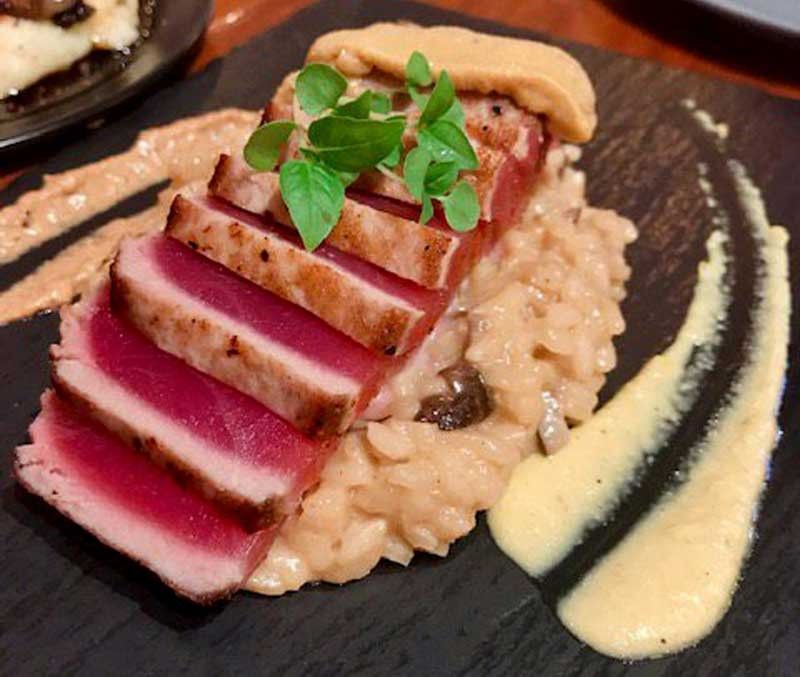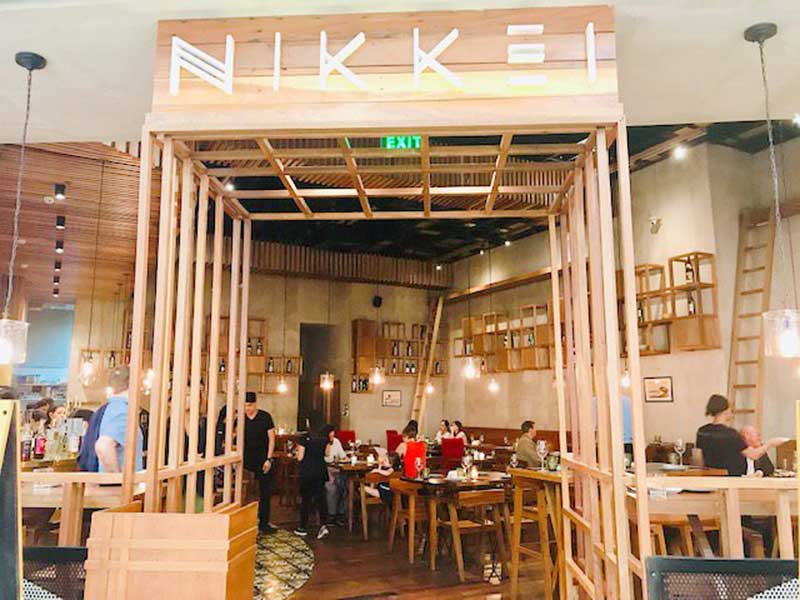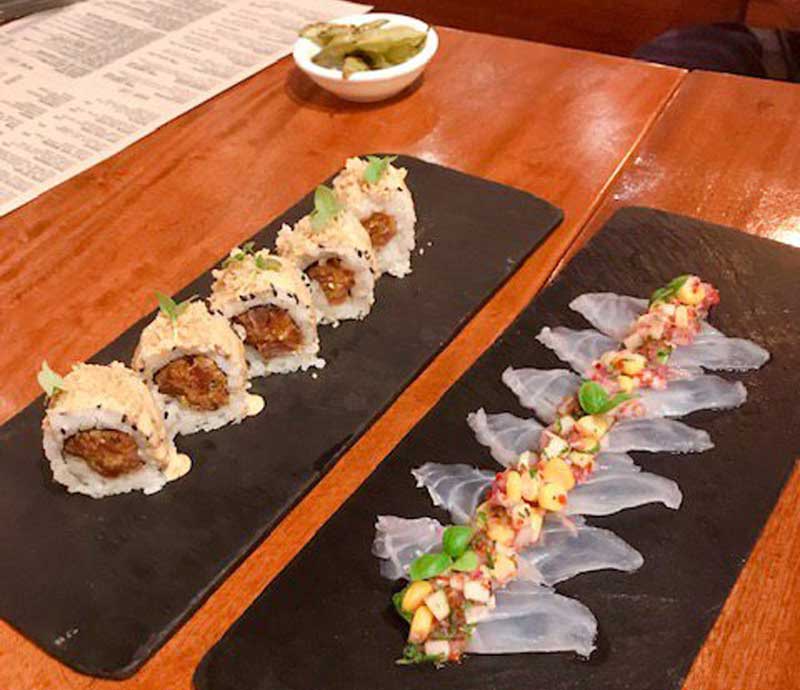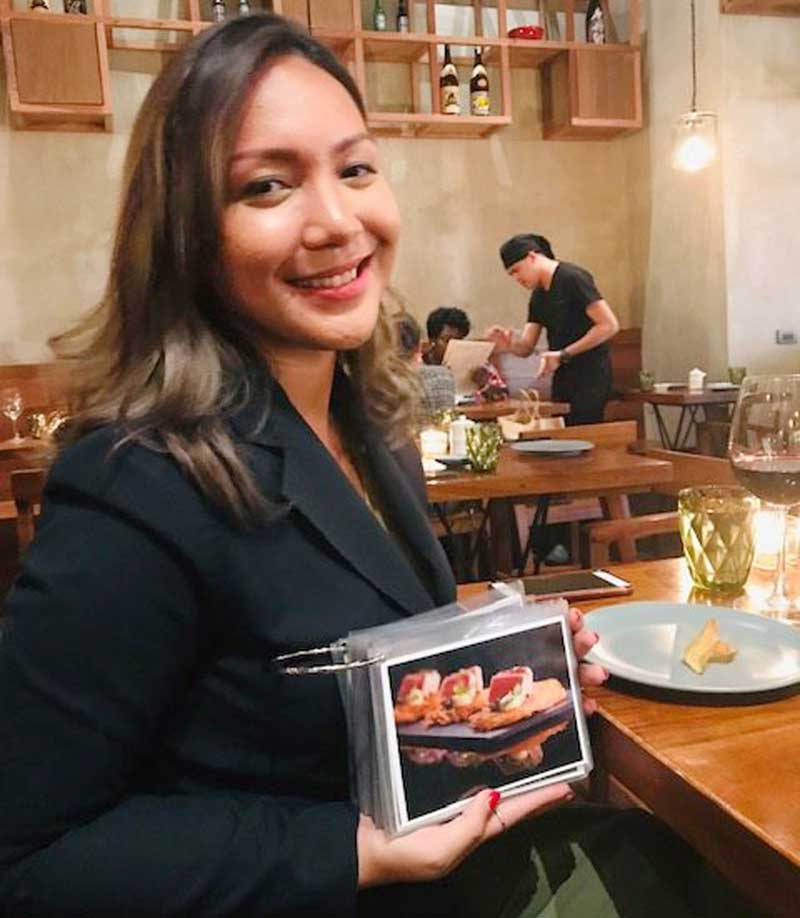A new world of Japanese-Peruvian flavors

Don’t let Nikkei’s chic interiors fool you: it’s a smart-casual resto where you can get a sushi special with drink for P199, or enjoy lots of tapas-style small dishes with drinks.
A couple of years ago Therese heard about this hip new eatery on Rada Street in Legazpi Village, Makati, that was Japanese with a Peruvian twist, and the modern, minimal interiors immediately attracted her. It looked pricey but she was pleasantly surprised to find out it wasn’t that pricey. In fact, she could well afford to bring her balikbayan friend there, and she had a fantastic dinner during which she took lots of photos showcasing the food and atmosphere.
That was her first introduction to Nikkei. She’d always been under the impression it was a foreign concept brought to the Philippines by some enterprising Pinoy, so imagine our surprise when Nikkei’s marketing manager Monica Modomo told us it’s actually a homegrown concept created by Carlo Gordon Lorenzana (from the Lorenzana family associated with Wildflour, Pink’s and Shi Lin).
Lorenzana, who also founded Single Origin, has not only grown Nikkei to three branches (Rada, One Rockwell and The Podium), but is planning to open a fourth with an even more modern concept. (More on this later.)

The Parmesan Scallops — cooked in Japanese butter, parmesan cheese and onion leeks — make for a silken, savory, sinful bite.
Sitting in the high-ceilinged Podium branch, Monica affably plies us with their signature cocktails (Therese had a white lychee-infused Sake Sangria that was refreshing, perfect for citrus dishes; Scott had a frothy Pisco Sour, made with Pisco Porton, a strong amber-colored brandy popular in Peru and Chile) before wheeling out dishes like Parmesan Scallops, cooked in Japanese butter, parmesan cheese and onion leeks, making for a silken, savory, sinful bite; and the best edamame appetizer we’ve ever had — lightly flamed after soaking in sea salt, clarified butter and sake.
“Nikkei means ‘Japanese outside of Japan,’” Monica informs us. “Japanese migrants moved to Peru for political reasons, but once they moved, they got a little homesick. They used the ingredients in Peru and mixed it with the Japanese style of cooking, so still a lot of seafood but more into the citrus flavors.”
Lorenzana, who was working with South American executive chef Juan Barcos at Argentinean steakhouse La Cabrera, wanted to do something Japanese, “but the South Americans were like, ‘You want to do something Japanese? Do it with South American flavors,’” recalls Monica. “So he got influenced and discovered Nikkei, which is Japanese-Peruvian.”
The whole point of Nikkei is to discover new flavors from the familiar realm of Japanese cuisine. “Those unfamiliar with the South American-infused casual-dining concept will stick to ordering sashimi and gyoza, but there’s so much more we want customers to know about,” Monica says.
She considers Nikkei an izakaya — a Japanese bar where you can enjoy lots of small dishes tapas-style with alcoholic drinks. Since many of Nikkei’s dishes are seafood-based, there’s a plethora of complementary white wine and sake on the menu, though they offer an extensive list of “Japeritifs,” cocktails, beers and spirits as well.

Way beyond ceviche: Nikkei in Podium is the third Manila branch to offer its stellar Japanese-Peruvian cuisine.
While we settled in with our drinks, more appetizers started appearing. Causa is another kind of starter — individual bites made from a Peruvian staple, the potato, mashed and topped with guacamole, your choice of seafood or beef, and chalaquita, or citrusy, red-onion salsa. In our case we had lightly torched Japanese Grade A5 Wagyu, and though we’ve enjoyed Wagyu many times before, this was a completely novel experience. We definitely weren’t in Japan anymore and had landed somewhere in Peru.
Possibly the most emblematic Japanese-Peruvian dish is ceviche, and the most striking of Nikkei’s versions is green due to a creamy wasabi sauce bathing squid, whitefish, octopus and shrimp. Wasabi fans will go gaga over this. We’re cautious wasabi eaters but this was just right: the horseradish kick mitigated by sweet potato strings and canchita, the South American equivalent of our corniks.
The next dish was notable not only because it was off the menu, but will also serve as the standard bearer for the restaurant’s offshoot concept, Nikkei Nama.
“Nikkei Nama will be my fourth branch in BGC, so it’s a taste of what we’ll offer,” Monica says. “I’ll be bringing in the sellers but also new stuff: more rice bowls, more playful, cheaper.”
The flagship dish is Tiradito, the Peruvian way of thinly slicing sashimi, flavoring it with citrus, and topping it with fresh corn kernels and chalaquita.
This was one of our favorites because not only was it beautiful to look at, the whitefish was incredibly fresh and sat lightly in the stomach.
“This is the quintessential Nikkei dish because in Japanese, nama means ‘fresh,’ it means ‘light,’ it means ‘quality raw seafood,’” Monica says. “That’s what we want Nama to be — also more relevant to the office workers and a younger crowd.”
Not part of the menu is the excellent spicy tuna roll, but you can have it as part of a sushi promo at the Podium and Makati branches: get five pieces of sushi with iced tea for just P199.
“We have express lunches like the sushi special because people think that Nikkei is so elegant or so snooty they can’t dine here, but we want to be relevant to the office workers,” reiterates Monica. “We want to be known as a smart-casual restaurant.”
Affordable seafood

From the upcoming Nikkei Nama branch in BGC, we sampled Tiradito — the Peruvian way of thinly slicing whitefish sashimi, flavored with citrus, and topped with fresh corn kernels and chalaquita — plus the excellent spicy tuna roll.
Though signature dishes like the Seared Tuna with Sea Urchin Risotto and new dishes like the Nikkei Black Cod with Honey Miso and Onsen Egg demand top-quality seafood on the plate, Nikkei head chef Richie Buenaventura says they keep prices affordable by sourcing most of their ingredients locally.
“The fish is sustainable and we have local oysters from Aklan,” he notes. “The edamame is from Japan, and also the black cod, salmon and Wagyu. Chef Juan visits every three months and we go marketing together. We do research and development most of the time.”
Trained to slice fish the Japanese way by a master sushi chef, Buenaventura currently has 30 chefs working under him for Nikkei’s three branches, and he’s been busy readying the fourth.
“We’ve been preparing for a year for Nama, where we’re introducing 20 to 30 new dishes,” he says. “I love what I’m doing,” and it shows.
Brand-new flavor world

Nikkei manager for training and marketing Monica Modomo
Winding down towards the end of the meal, we have tres leches — sponge cake soaked in custard cream — with very Pinoy sweet mangoes on top and very Japanese soy syrup drizzled on the plate. Washed down with Brazilian coffee brewed via the Japanese drip pour-over method for Scott and Eve’s Rose Petals herbal tea for Therese, we muse about how far Nikkei has come from its first branch, which opened along Rada St. in 2015.
“A lot of expats and tourists come and think it’s a franchise from Milan, London or San Francisco,” says Monica, who was educated and lived for a while in the United States. “We host jazz events with different artists and also have samba at One Rockwell because it’s a bigger space. We want a place where people can just relax, have a glass of whiskey, enjoy good music…” And, of course, discover an exciting new world of Japanese-Peruvian flavors.
* * *
Nikkei is located at Frabelle Business Center, 111 Rada, Legazpi Village, Makati, tel. 880-0231; 71 Rockwell Drive, Makati, tel. 0916-636-9817; and inside The Podium, Doña Julia Vargas Ave., Ortigas Center, Mandaluyong, tel. 0995-908-3145.
Special offers include the P199 sushi lunch special with iced tea; buy-two-for-one Sake Sangrias for P500 from Thursday to Sunday; and for Oktoberfest, choose a beer bucket, mix-and-match six beers and you get a free sushi roll or bar chow.
Nikkei Nama will open by the first week of November in Bonifacio Global City, Taguig.



















